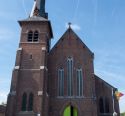Church | 1853-1857 | Neogothic | Catholic Church


Map
Opening hours
01 April - 30 September
Mon 9.30 - 17.00
Tue 9.30 - 17.00
Wed 9.30 - 17.00
Thu 9.30 - 17.00
Fri 9.30 - 17.00
Sat 9.30 - 17.00
Sun 9.30 - 17.00
01 October - 31 March
Mon 9.30 - 16.00
Tue 9.30 - 16.00
Wed 9.30 - 16.00
Thu 9.30 - 16.00
Fri 9.30 - 16.00
Sat 9.30 - 16.00
Sun 9.30 - 16.00
Except during special events (cycling contest,annual fair,...)
Religious offices
Description
In 1231 the church of Grotenberghe is mentioned for the first time in literature. It was probably a wooden building that was later replaced by a stone version. Priest and architect Jan August Clarysse was ordered to draw plans for a new church in 1853, in all likelihood because of the run-down state of the stone building. The new church eventually became a copy of the pseudo-basilica Saint Lawrence church in Poesele. It also is the first successful example of a neo-Gothic church in Zottegem.
In four years time (1853-1857) not only the church was built but the furniture was also decorated. The rather radical decision of the architect to only use neo-Gothic furniture creates a beautiful union of style. The only exception to this neo-Gothic union is the bell in the choir. Along with the adequate proportions of the building, this bell is one of the key assets of the church.
Matthias Zens, an artist from Ghent, finished the church at its current condition at the end of the nineteenth century. Fun fact: This church is probably the only church in Zottegem where there are no paintings.
During the last restoration in 2001, the white paint of 1945 was removed to reveal the original polychrome again. In 2004 the church and the interior became protected heritage.
Source :
Geert Van Bockstaele, Grotenberge. Kerk en Parochie 1232-2005
Grotenberge 2005 & Geert Van Bockstaele, De kerk van Sint-Pietersbanden en Sint-Berlindis te Grotenberge, Zottegem 2009
KIKIIRPA : Photo-library online
Photos
Remarkable elements
Communion rail
Neo-gothic oak communion rail, in 1883 ordered from sculptor Matthias Zens. The panels bear symbols of the Old and New Testament.
From right to left: The Cross of the Passion, the Arc of the Covenant, the wafers, a chalice, a host-bearing chalice, a pelican, the Lamb of God, the IHS monogram, the corn ears, the manna from heaven, the serpent in the tree in the Garden of Eden, and a cross with crown and nails.
Confessional
The confessional was made by sculptor Charles Bruggeman from Ghent in 1858. On the columns on either side of the central door are St. Peter and St. Paul. Through their imprisonment they can help save the souls of the faithful.Pulpit
Accounts from 1861 show this pulpit was made by sculptor F. or N. Goemans from Antwerp. The three panels show the multiplication of the loaves, the Sermon on the Mount and the Last Supper. Between the panels are the four evangelists and their symbols: Marc with lion, John with eagle, Luke with ox and Matthew with angel.Organ
In August 1855 a contract was signed with organ builder Louis Lovaert to deliver a new organ, ready to be used and played because that same month the bishop was expected to visit and inaugurate the church. The organ case was designed by architect Jan-August Clarysse. In 1980 the organ was officially put on the national heritage list.Stations of the cross
The new Stations of the Cross, made by Matthias Zens, were put in place in 1881. The names of the benefactors were painted over in the 1970s. Thanks to generous gifts from the parishioners the Stations of the Cross were restored in 2001, once again showing their original colors.Main altar
The altar tomb was carved by marble sculptor Petrus Sarot after a design by architect August Clarysse who also designed the church. The stone bas-relief is in typical neo-gothic style. The recesses contain plaster statues of St. Cornelis, St. Peter and St. Berlindis by sculptor Jean-Baptiste Van Biesbroeck from Ghent.Around the altar wall paper carries symbols of the Passion of Christ and the Eucharist. This paper has been largely obscured by the altarpiece made by Matthias Zens 30 years later. Left, the altarpiece shows the birth of Jesus and right the Last Supper.




















